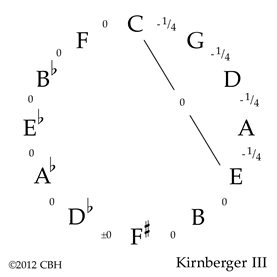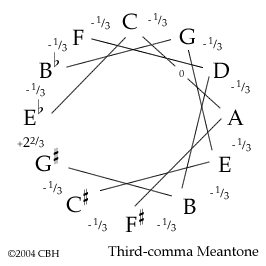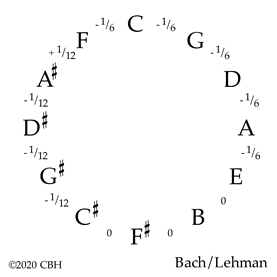Technical Library
TEMPERAMENTS I: Temperament FAQ
Entire Contents Copyright © 2020 CBHTechnical LibraryTEMPERAMENTS I: Temperament FAQ Entire Contents Copyright © 2020 CBH |
 |
 |
 |
 |
 |
 |
 |
 |
 |
Temperament FAQ…
Q: What is Temperament?
A: Temperament is the division of the various notes of the keyboard and the relationship between them, often producing intentional musical results.
Q: Is Temperament necessary?
A: Indeed! Pythagoras discovered so many years ago that if you tune a series of acoustically pure
perfect fifths (C–G–D–A–E–B–F♯–C♯–G♯–D♯–A♯–E♯–B♯…) by the time it looks like you are getting back to the beginning you are actually out
of tune: The B♯ is not the same note as the C you began with.
In fact, it is sharp by the amount we now call the Pythagorean comma. What
you have isn’t a Circle of Fifths, but a spiral, much like
an orange peel. The purpose of temperament is to squash this spiral into a circle.
Q: So an A♭ isn’t the same as a G♯?
A: No, not always: In musical notation, a perfect fifth above C♯ is G♯ because musical intervals are always counted by letter names. (C,D,E,F,G is five; no matter whether they are sharps, flats, naturals or mixed.) It becomes a little more interesting with a keyboard, because one physical key to depress may have several roles or names, although its tuning must be predetermined. If you want an A♭, it’s always a perfect fifth above D♭, never C♯.
Q: Is temperament the most important thing in music?
A: No—although some aficionados would beg to differ, and it has driven people crazy for centuries. There is, however, a great advantage to understanding what is happening in music. The difference can be remarkable when you hear the music come to life merely because an appropriate temperament has been chosen to match the repertoire.
Q: How many temperaments are there?
A: Countless.
Q: How many temperaments do you discuss here?
A: Over twenty and counting…
Q: Why bother? Isn’t Equal Temperament without peer?
A: Equal Temperament is wonderful, allowing music to freely modulate and each note serve multiple purposes. However, this comes at a cost which was not so much desired in earlier times:
Q: But didn’t Bach invent Equal Temperament? If it’s good enough for him…
A: Despite what you might have been taught, Bach neither invented
nor used Equal Temperament. He probably used many different tuning systems—if
he had one particular one in mind for any of his works, he never chose
to write clear directions for setting it. Note that his great opus is called the Well-tempered Clavier in English, not the “Equal Tempered Clavichord”,
as it has too often been mistranslated. You will find several Bach temperaments discussed in these pages. Some are connected to Bach because they may have been known to him through treatises (Werckmeister III) or colleagues (Silbermann), or proposed by a pupil (Kirnberger III). In modern times, Bach temperaments have been postulated based on his Signet ring (Kellner), subjective mathematical analysis (Barnes), or even the ornaments occurring in the left hand of a particular piece of music. Several musicologists and performers have recently proposed a variety of temperaments based on a calligraphic squiggle (Lehman, O’Donnell, Hill, Swich, …).
Q: Why should I explore the earlier temperaments?
A: Temperaments other than Equal are well worth your investigation. The earlier temperaments are much easier to set by ear because fewer intervals are
tempered, and those that are, are tempered to a much greater degree than all
those slightly-narrowed fifths in Equal Temperament. This means that even ordinary musicians can
hear them. You don’t need perfect pitch, just to be able to listen.
Q: Can’t I just use an electronic tuner, or an app?
A: Yes, of course you can. These are quite popular, and each are discussed on their own page; either for Electronic Tuners, or Apps. The danger in using such aids is that you may not actually understand the relationship between the various notes or what you are trying to accomplish. Some would say this is less of a disaster for a keyboardist where the notes are ready-made—although somebody had to make the decision where to place them. If you have a little knowledge of the structure of various temperaments, you will find increased enjoyment in your music making and listening, even if you decide to use an artificial tuning aid to initially build your confidence and verify what you are hearing.
Q: So that’s why you don’t just list the cent deviations for each temperament you discuss?
A: Exactly.
Q: I’ve heard about Meantone. What is it?
A: There are many varieties of Meantone, several of which are described on the following pages. The most common—and the one understood if the term appears without further qualification—is Quarter-comma Meantone. It’s suitable for early Italian music in particular, but much more besides. Here, the comma is divided into four and all the fifths are tuned the same size. There is a large error left over, known as the wolf. Quarter-comma Meantone is remarkable for the absolute purity of its Major thirds in the most-used keys. There are only three key colors: Good, bad and ugly, so if you stray too far you will certainly hear it!
Q: How can I decide which temperament to use for which piece?
A: Some suggestions are made on the following pages.
 Q: Can I damage my harpsichord by too-frequent tuning or change of temperament?
Q: Can I damage my harpsichord by too-frequent tuning or change of temperament?
A: No, I hope not. Harpsichords by their nature are made to be tuned, and there is no harm caused. On the contrary, the cone-tuned metal pipes of many organs are fatigued by too-frequent tuning: Such instruments are intended to be set and forgotten. If you are radically changing temperament on your harpsichord, you may find some instruments require an additional tuning or two for maximum stability.
Q: I want to spend most of my time playing, not tuning. Is there a multipurpose temperament?
A: Many players are happy keeping their instrument in a so-called well temperament. Vallotti is commonly used because it has a pleasantly even progression of key colors and you can play in any key you wish. Those keys closer to C have slower beating Major thirds than the more remote keys, giving the former a sweeter sound. While this is one of the easiest temperaments for modern piano tuners to get their head around, it is probably not the easiest choice for beginners to accurately set.
Q: Then what about a temperament for a first-time tuner?
A: I recommend Kirnberger III as a good starting point. It is relatively easy to set, you can play in almost any key, and it forms a convenient base to change into other temperaments as you gain confidence and wish to explore further.
Q: So where do I begin?
A: Understand the Pythagorean Spiral, and make sure you can hear and tune an absolutely pure perfect fifth. If you navigate through each page in turn, you will soon reach Kirnberger III.
Q: But I’ve never tuned a harpsichord before!
A: Check the Harpsichord Tuning Process page first. When you have the opportunity, look, listen and learn—maybe you’d even like a tuning lesson.
Happy exploring!
| Pitch nomenclature | |
| Harpsichord Tuning Process | |
| Tuning Bibliography | |
| Technical Library overview | |
| Harpsichords Australia Home Page |